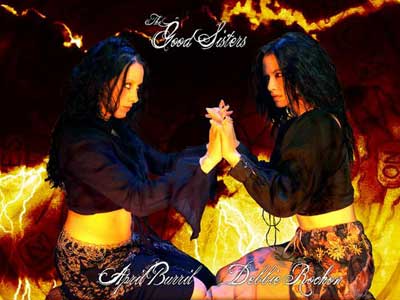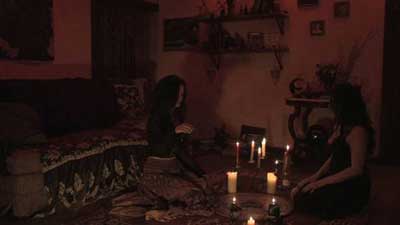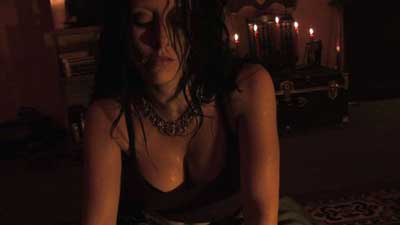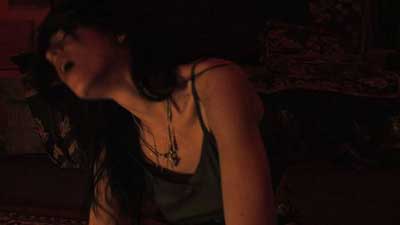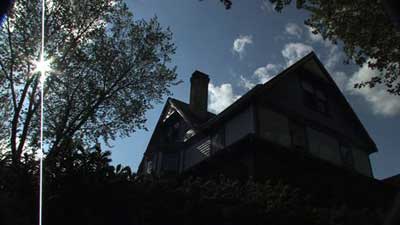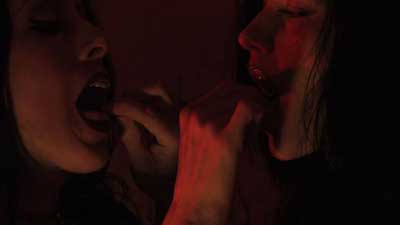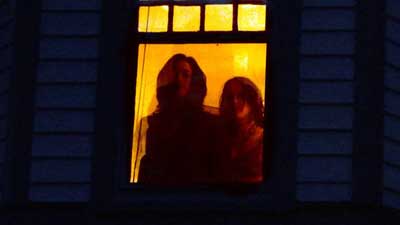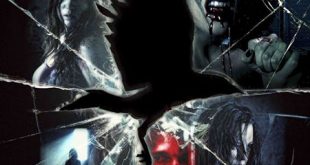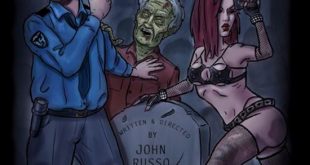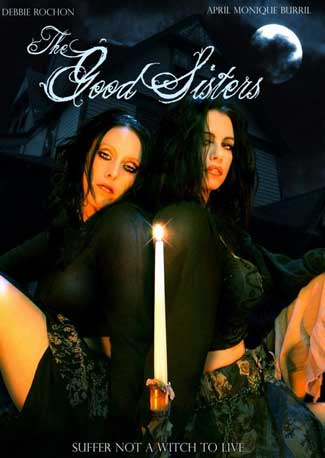 Since the classic film Haxan: Witchcraft Through the Ages, cinema has been bewitched with the various guises of the occult within its frames. Yet with typical Hollywood foible, the representation of the esoteric in cinema is cursed within blasphemous misrepresentation. Most of what is illustrated on screen as actual witches or practicing magickal formula is far strayed off of its already crooked path. Although experience of metaphysical phenomena is subjective, just what is portrayed cinematically as actual occult possibility within existential realms is masked within sensationalism and formulaic fraud.
Since the classic film Haxan: Witchcraft Through the Ages, cinema has been bewitched with the various guises of the occult within its frames. Yet with typical Hollywood foible, the representation of the esoteric in cinema is cursed within blasphemous misrepresentation. Most of what is illustrated on screen as actual witches or practicing magickal formula is far strayed off of its already crooked path. Although experience of metaphysical phenomena is subjective, just what is portrayed cinematically as actual occult possibility within existential realms is masked within sensationalism and formulaic fraud.
Horror continues to summon forth demons of visual and conceptual misrepresentation as if attempting to embody and perpetuate the scriptural “liar” and “deceiver” aspects of the spiritual dark side to cinema.
The list of films offering an optical possession of false celluloid occult idols is legion. Some of these films, written or directed by serious industry professionals, still straddle the Devil’s quixotic plotline to ridiculous comical directions.
Luckily such misguided esotericism has been bound by the cinematic spell work of one visionary filmmaker. The occult or witchcraft more specifically, has finally been captured by someone practicing the arts of research and realism within his film, an often forgotten concept of contemporary filmmaking. That man is JimmyO Burril and his film is The Good Sisters starring April Monique Burril and Debbie Rochon.
The tale of The Good Sisters chronicles the life of Breanne and Kindra Good, two tenth generation modern witches descended from the historic alleged Salem witch, Sarah Good. Historically there is no record of whether Sarah Good actually had sisters but it is within the realms of possibility. As JimmyO comments,
“Yes, they are the fictional descendants of Sara Good, who was one of the first women killed as a witch in Salem. I looked and could find no record of real descendants from that family, although, I’m sure there may be”.
As if mirroring 17th century New England Puritanical intolerance, Breanne and Kindra continue to invoke the same persecutions into the current aeon of their private lives that the authentic witches of Salem experienced. Such prejudice, social intolerance, and may be said to be the underlying theme of the film.
As the story progresses, the lives of the sisters become enveloped within a contagion of turmoil both internally and externally. Breanne and Kindra spiral ever deeper into paranoia, psychological instability, and a magickal dependency. The sisters slowly unravel from the effects of a sociological alchemy of intrusive neighbors combined with an element from their past that seems to be both haunting and hunting any tranquility their existence as humans and modern witches may manifest.
Debbie Rochon and April Burril capture the psyche and visual aesthetics of the modern witch with a natural realism that compliments both their talents as actors, as well as the writing abilities of JimmyO. The characterizations of Breanne and Kindra encapsulate what may be termed a physical embodiment of the collective duality of the feminine principals. Breanne as the older sister, portrayed by Debbie Rochon, emanates the energies of the wise woman. She is a witch and a woman combining physical beauty with the logic of the Mother aspect of the feminine Triple Goddess triad. Breanne attempts to maintain the control and focus of their actions and perceptions as their lives become unwillingly entangled within their surroundings.
Kindra, the younger sister portrayed by April Burril, breaths forth the philosophically rebellious principal of youth and sexuality. She is the Maiden principal incarnate. The psychic and emotional dynamic within Kindra keeps sensitivity and passion perpetually rendering the veils of experience. They are elements that may produce swift conclusion to their circumstances, but still need the balance found within Breanne.
It is no cinematic coincidence that a horror film containing elements of real magick would actually aggregate real magic between Rochon and Burril. The onscreen symbiosis between Debbie and April indicate that what they were experiencing and expressing visually was more than well-studied characterization and acting abilities. There was in fact a real exchange of energy between the women, one that can only be explained as genuine occult phenomena captured on film. As JimmyO relates,
“They created REAL moments on camera. They were there… acting was out the window. We were seeing two real women create a real situation for us to document. It was chilling at times.”
This sisterhood between Debbie and April may even be the unconscious inspiration for the film itself. When asked what the genesis of the project was Jimmy responded,
“The entire movie was inspired by a photo I took of April and Debbie at a horror convention. They were hugging and looked so happy… they looked like long lost sisters who had just found each other. April herself acknowledges this kindred she shares with Debbie,
“At the start of The Good Sisters project, I already knew I would be learning a lot about the acting craft by working with Debbie. And I also knew that – physically – we were convincing as sisters. What I never expected to find is someone that is such a kindred spirit. There are some deeper aspects of my personality – things I never discuss with anyone – that she shares. I don’t care to talk at length about it, but suffice to say… I have some secretive tendencies and I was amazed to find another person sharing them. More on the surface, as we got to know each other before shooting, we discovered a common affection for the occult and, on occasion, worked on various rituals together (via long distance – we’d agree on certain times and other details) to help get ‘in sync’ with one another.
The whole thing was a fascinating experience. I feel I grew and learned a lot working with Deb and look forward to our next opportunity to share a project.”
One may even find an esotericism within the names of Kindra and Breanne Good when examined deeper. When analyzed through Gematria, a Kabbalistic method of interpreting the Hebrew scriptures by computing the numerical value of words, based on those of their constituent letters, we find some interesting correspondences. The name Kindra Good, reduced beneath Kabbalistic formula as KNDRA GOD (the repeating O is eliminated to interestingly become “God”) equates to 352, a number corresponding to lightning and exalted light, two concepts loaded with spiritual natures within not just Judeo Christian traditions but most magickal systems. When embracing more simplistic numerological practice 352 reduces to 10, a number itself full with magickal properties. It is also a number, according to Aleister Crowley, attributed to “enchanter, wolf, and a hidden place.” The occult significance to these three correspondences is self-evident to even the most elementary intelligence. Breanne Good interpreted under this formula becomes BRYAN GOD equating to 340, a number attributed to among other things, to “ferocious lion”. The lion is a zoomorphic image for the energies of Leo, sexual heat and desire, as well as basic creative principles. The strength and wisdom of the lion/lioness are qualities evident within the character of Breanne. When 340 is reduced the number 7 is yielded. The number seven has spiritual aspects within every tradition ranging from aspects of creation, celestial natures, to being a “lucky” number. There is an interesting polarity between the lunar wolf and the solar lion symbolisms here that may be found embodied within the sisters who themselves express certain elements of psychological balance.
The magick within The Good Sisters of course is not limited to simply the writing and acting, their was research and possibly an innate spiritual wisdom incorporated into the very essence of the plotline. Unlike the sensationalized rituals within most horror films, the spells within The Good Sisters are real. This is evidenced from the initial, and very alluring scene, where Breanne and Kindra are utilizing the Ouija board for invocatory magick. In regard to the authenticity of content, JimmyO acknowledges,
“Well, it’s NOT The Craft… or Charmed. It’s based in the real world… not what the witch image is as designed by Hollywood. We do use real spells and real chants as we found them in a variety of witchcraft books.”
Watching the film, the ocular senses are immediately sucked into a visual vortex of metaphysical bewitchment. A cacophony of dark primal tribal music reverberates in the background while the sisters are entranced within an invocation of trans-dimensional energies through the medium of the Ouija. Although the use of the Ouija board is controversial in terms of being a physical ingredient for communication with spiritual recesses, the sister’s use of the board to access non-physical planes is not far fetched formulaically. It is the most significant means the sister’s use to manifest energies for their personal magick as well as establish communication with the spirit of Sarah Good. Kindra and Breanne do not simply use the board, as would most individuals. They focus it as a portal of sorts, centering the board beneath an air of ritualistic technique and corresponding magickal elements. It is this inclusion of the Ouija as an integral piece to larger magickal puzzle that makes the reality of its cinematic use plausible.
The Ouija created by April Burril for the film is a work of art. A circular board, a geometric itself representing infinity, feminine natures, and the ability of consciousness to transgress these barriers, has a twelve pointed star surrounded by letters transliterated into witches runes. The connection formed between the sister’s bodies and the board as an inanimate medium of spiritual creates an impressive visual of evocation.
The sisters employ the use of Lilith throughout the film, summoning her natures as a means of personal protection and power. Surrounded by a circle of salt upon the seashore, the sisters seek out her “guidance”. Lilith, a Sumerian demon/succubae/Goddess force, has varied magickal correspondences and natures within genuine occult tradition, and her use as a protective element within the sister’s magickal arsenal is one correct practice. Modern witches often employ Lilith, despite her demonic attributions, as an embodiment of the Goddess energy. Lilith is the prototype for the rebellion and forcefulness of feminine natures, aspects easily found within the sister’s characters. We also see Lilith’s aspect as nocturnal terror expressed within the sister’s later invocatory inclusion of her name and energy in their ritual as they inflict nightmare magick within each of the neighbor’s dreams. It is this nocturnal aspect of Lilith that may correspond to her natures as a night demon typical of Jewish folklore. Lilith is also considered by some as a “mother of abortions”, visualized within the film by the miscarriage one of the neighbors experiences during the sister’s nocturnal spells.
In terms of spell work, Breanne and Kindra employ many authentic procedures through out the film. Most of their magic, in the form of binding and cursing, are utilized as a means of protection against their neighbors and works on a dream and unconscious levels, two standard and effective methods of activating spell work. Binding spells in reality are used to cease or “bind” certain activities or projected energies from external sources detrimental to the individual. We see these bindings within the sister’s magick primarily illustrated taking effect within the dreams of the neighbors. It is within dreams and nightmares that many forms of magick, especially of the kind falling under the term of black magick, may be successfully worked. It is within the time of sleep that the essence and energy of individuals are most accessible and vulnerable.
The sister’s use of binding spells as a means of dealing with their situation indicates yet again that the research of JimmyO was right on track formulaically. Not only are the sister’s bindings realistic, they are written with a haunting poetry.
North, South, East, West
Spider webs shall bind them best
East, West, North, South
Hold their limbs and stop their mouth
Seal their eyes and choke their breath
Wrap them round with ropes of death
The presence of the spider and webs within the binding conceals a much greater and darker esotericism then the average viewer would normally comprehend. On the surface, the use of the spider and webs within the concept of binding is obvious. They are primarily symbolic of feminine mysteries. The spider and its webs in fact hold significance within many occult traditions and cultures. Their use in binding spells is appropriate in regard to black magick or left hand traditions as a means of trapping both benevolent and malevolent forces. Interpreted esoterically and in terms of spirit communication, it is the spider’s web that symbolizes the networking leading to other dimensions significant to the communion with the spirit of Sarah Good.
The escalating paranoia of the sisters brings them into more obsessive states, sending their spell work into darker strains of practice. They believe that the neighbors have invaded the privacy and sanctity of their apartment, symbolic of their temple and sacred personal space. One of their magickal implements is found to be missing validating this concern. The sisters begin collecting samples of hair from each neighbor as part of their plans for protection and magickal retaliation. The use of hair as a means of cursing is infamous within all occult traditions. Artifacts from the bodies of those being worked against such as hair, fingernails, and blood each keep an aspect of the person’s essence and energy. Such intimate links allow the magickian the ability to have an equally intimate access to manipulate, harm, or heal those the magick is aimed at.
The banishing ritual within this performance involves a strange yet erotic visual involving the sister’s feasting upon and crushing of a tomato. The tomato, usually utilized within works of love sorcery, here holds a malefic symbolism as being the collective heart of the neighbors the binding curse is focused upon. The devouring and destruction of the tomato represents the sister’s cursing of the neighbors, which again affects the whole of the neighbors subconscious dream states. The nightmares the binding invokes arises images of physical binding within the non-waking realms suggesting a complete physical and psychological effect of the spell.
In a continuation of their magick, the sister’s create a tincture of various herbs combined with the menstrual blood of Kindra. Menstrual blood is a notorious within magick, found in certain cultures as an ingredient infused into teas and cakes for seduction spells. It of course has much darker uses beyond the manipulation of love energies.
The connection of menstrual blood to the witch may be found in its more esoteric natures and correlation to the fiendess Geh, whose number of 13 represents the cleaver or divider of time symbolized by biological menstruation. Geh or the “insane woman” connects to the witch as an archetype of Hekt or Hecate as “hag” or witch type of transformation, yet again an element corresponding to the dark blood of the feminine as well as with Lilith in her serpentine aspect. There is also an inherent esoteric vibratory nature of death contained within the esoteric interpretation of the blood that is utilized with practices of black magick.
In terms of what the Good sister’s perform, menstrual blood is used to connect its essence and infused magickal intent with the disembodied realms inhabited by the spirit of Sarah Good. The blood included within the recipe added to the necessary corresponding elements for that specific intent of the spirit summoning. In terms of cursing and binding as practiced by the Good sister’s, menstrual blood was also employed for the use of disrupting the flowing of energies as represented by the opposition by the neighbors.
The tincture of herbs and blood is then painted upon both the walls of the apartment and upon the sister’s flesh. Such practice would serve two purposes. First, it would form a barrier that would enclose and concentrate the energies summoned within the room as well as prevent anything external from entering. Second, being upon the flesh of the sister’s it would form that same concentration, as well create a deeper connection of their mind and body complex with whatever is summoned.
During preparation for the ritual, the sister’s find a human tooth upon the floor. Deducing it is from one of their enemies it is included within the subsequent working. The use of the tooth within the ritual forges a magickal connection with the enemy, as did the use of hair, a practice that would in reality allow the witches to defend themselves and attack.
Readied, the sister’s then conjure the spirit of Sarah Good. As they employ the Ouija in the invocation, the planchete spells out the warning of “suffer not a witch to live”, a verse from the book of Exodus. This validation from the spirit of Sarah confirms to the sister’s that their fears are in fact grounded in some form of reality. The spirit of Sarah yet indicates that she cannot protect them from the circumstances but will guide them in their magickal pursuits. The following message from Sarah of “sacrifice” brings their magick into the most black, controversial, and misunderstood of practices in occult tradition, that of animal sacrifice, here taking form as a black cat belonging to one of the neighbors.
To most witches the practice of animal sacrifice is strictly forbidden and condemned and falls under the domain of pure black magick. Within traditional practice sacrifice has two intents. The most obvious is one of an offering of the animal’s spirit unto that which is being summoned. On a more symbiotic level, it is the death throes of the animal that are invoked into the individual performing the sacrifice allowing them both additional power and a vampiric devouring of the essence of the creature. Within the film, the sacrifice of the black cat is used as a warning to the neighbors as its disemboweled carcass is strung upon the front doorstep of the house among a collection of painted bloodstained symbols of both protective and cursing natures.
The paranoia of Kindra and Breanne eventually escalates to needing the degree of power that can only be found within a human sacrifice, a sacrifice in the form of a preacher. The ritual involved in the human sacrifice involves the two most powerful forces found within the embodied human, sex and death. The sacrificial rite within the Good Sister’s is perhaps one of the most hauntingly erotic scenes within contemporary horror. Kindra and Breanne, half naked and painted in symbols of blood, summon the spirit of Sarah while mutually masturbating each other. Chanting “Thrice around, circle bound, sink all evil to the ground”, the sisters generate a circle of sexual energy culminating in the stabbing and eating of, the sacrificial heart.
Within most occult traditions the use of sex energy as a means of generating power is common.
There is no greater force to be summoned within the human body than sex energy. We find examples of this within every tradition from Western Paganism to more complicated Eastern Tantric systems. Sex energy now combined with death, or the stabbing and imbibing of the preacher’s heart for example, illustrates that the magickal formula of sex and death combined can be powerful enough to summon forth energy that if unable to handle, can induce madness. We see this suggested in the finale where the sisters madness and obsessive paranoia after the sacrificial invocation besets upon them a power and dark focus of unhinged degrees. Most occultists will publically condemn human sacrifice out of ethical of perhaps simply legal reasons.
Human sacrifice is most often misrepresented in terms of its actual worth within magick. Regardless of the ethical, moral, and legal issues, sacrifice whether animal or human, generates a rare degree of energy that cannot be replicated by symbolic means. One need only consult the religious history of mankind to find it ripe with examples of sacrifice for either invocatory or offertory purposes to deities.
The authentic occultism within the Good Sisters is not just found within its visuals. There are possibly unintended deeper occultisms of the kind JimmyO either captured accidently or unknowingly intuited through his creating of the film. It is these things slipping through the in between of consciousness that often conceive of things that only may be found within those concepts existing behind, beneath, and between the dimensions of consciousness.
The lighting within the film conveys a darker element beyond simply what is seen within the film. It illuminates the viewer into much more. As JimmyO states,
“You can take the most innocent place on the world, change the lighting and make it the most sinister place in the word.
The scene where Kindra and Breanne are spying outside of the house of a neighbor is a perfect example. The nocturnal lighting, whether actual moonlight or simply off screen lighting, generates a shadow of Kindra’s profile that is disjointed and unnatural. This unnatural illusion of flesh or more specifically here the embodiment of the witch Kindra represents on the surface, an expression of the popular cliché of the archetype of the ugly witch. Of course this classic representation has origin in political and sociological prejudices but esoterically holds significance beyond those known to ordinary awareness. The image of the ugly witch represents the natures within those recesses beyond the phenomenal universe. The ugliness and the primal fright she typifies are those demonic energies kept within the realms of cosmic and trans-human darkness.
The unspoken occultism within the film is not contained to the sister’s themselves. The house that they live in also is representative of serious esoteric symbolism. On the external the architecture of the house, typical colonial of New England, represents the classic haunted house. The house used within the film is a real place and not something created on a sound stage. As JimmyO relates,
“I have a friend who owns a large old home here in Maryland. He let us use the home as the apartment building. So we are almost entirely there, except when we are in the sisters apartment.”
The haunted house and the angles of its architecture alongside the disembodied energies contained within it all have an interrelated connection. Within occult interpretation haunted houses are known to generate unharmonious frequencies affecting physical phenomena and emotional, psychological, and psychic states of both the living and the dead connected to its domain. The house and sister’s apartment within the film is not just a larger physical gateway to the disembodied spirit of Sarah Good; it is a conductor of sorts of the power of their witch lineage.
Another interesting example of unspoken occultism is the apartment numerology. The interstice between their apartment three and the neighbors of number two equals 23, a number of great occult significance. The number 23 is infamous as a number of baneful luck and chaos. It is a numeral for the influx of forces beyond the phenomenal universe, those forces typical of demonic realms. In regard to the sisters, it represents their connection with the natures of magick, witchcraft, and the disembodied spirit of Sarah Good. In terms of being an unlucky number, it would suggest the madness and ultimate downfall the sister’s experience within the finale of the film.
Within a genre where the occult is misrepresented more often than not, the Good Sisters evokes a magick resulting in a vision of a future where the occult no longer strays off the path of visual inaccuracy. With the Good Sister’s, viewers shall experience a welcomed bewitchment of actual occultism and not exaggerated nonsensicality typical of Hollywood. Sociologically, The Good Sisters is a film of modern day prejudice against individuality and subculture lifestyles. The film perfectly captures something that many witches, Pagans, and occultists of all traditions have experienced for as long as provincial daunted attitudes of humanity have possessed the collective consciousness.
To summarize, The Good Sisters is an unusual film of paranoia and self-fulfilling genealogical prophetic tension all wrapped beautifully within an evolving coherent plotline of occult realism. Viewers will find that it is one of the most hauntingly erotic films to bewitch the horror genre is ages.
 Horror News | HNN Official Site | Horror Movies,Trailers, Reviews
Horror News | HNN Official Site | Horror Movies,Trailers, Reviews

